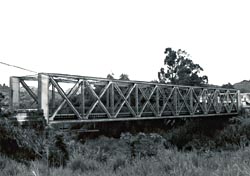Arenas Bridge
Coordinates: 18 ° 8 ′ 6 " N , 66 ° 8 ′ 17" W.
| Arenas Bridge | ||
|---|---|---|
| construction | Truss girder bridge made of steel | |
| completion | 1894 | |
| planner | Mariano Sichar; Nicrisse & Decluve | |
| location | ||
|
|
||
The Arenas Bridge in Cayey , Puerto Rico is a steel truss bridge built as Puente Rio La Plata in 1894 and the longest bridge built in Puerto Rico during the Spanish colonial era. She crossed the Rio de la Plata , the longest river on the island. The National Park Service describes the bridge as "the most important metal bridge in Puerto Rico from that time". The structure is still in use.
The bridge was built as part of Carretera Central , the first country road through the central mountains of Puerto Rico. The 134-kilometer long highway connects San Juan with the port city of Ponce and was largely completed in 1886, with some bridges only provisionally built and only 13 bridges permanent. The final Arenas Bridge was built in 1894, four years before Carretera Central was completed in 1898.
Due to the rarity of iron as a raw material in Puerto Rico, there were no steel production companies on the island, so structures like this were produced overseas and then partially shipped to Puerto Rico. A trade agent for the Spanish government in Paris collected the international bids, mostly from British and Belgian companies interested in building bridges in the Spanish colonies. The Arenas Bridge was pre-produced by the Belgian company Nicrisse and Decluve and then shipped to Puerto Rico on the Teutonia steamship .
An alternative to building a truss bridge would have been a suspension bridge , which was an already well-developed technology to achieve longer spans before the bridge was built. In Puerto Rico, however, there was no need to build longer spans during colonial times, as there are no particularly wide rivers and gorges on the island. The chief engineer Manuel Sanchez-Nuñez decided that suspension bridges were unsuitable for the tropical climate and in 1857 had an already built suspension bridge in Caguas demolished. As a result, suspension bridges were not very common in Puerto Rico and even today there are probably only three such structures on the island, including a modern pedestrian bridge in Bayamón .
The building was planned by Mariano Sichar. Construction costs of 56,221 pesos were agreed for the steel bridge, the steel weight was projected to be 23,623 pounds. The stone abutments that were supposed to support the bridge were built under the supervision of José Roque-Paniagua, the construction of the bridge was supervised by the engineer Julio Larrinaga.
During the Spanish-American War , United States forces advanced south to north via the Carretara Central. Another bridge was destroyed by the Spaniards to slow the advance of US troops, but the Arenas Bridge was spared.
Individual evidence
- ↑ a b c d Historic Places in Puerto Rico and the Virgin Islands: A Travel Itinerary: Arenas Bridge . National Park Service. Retrieved November 10, 2010.
- ↑ Luis F. Pumarada O'Neill: National Register of Historic Places Multiple Property Documentation: Historic Bridges of Puerto Rico, c. 1840-1950 ( English , PDF, 32 kB) National Park Service. P. E-7. July 31, 1994. Retrieved November 10, 2010.
- ↑ Luis F. Pumarada O'Neill: National Register of Historic Places Multiple Property Documentation: Historic Bridges of Puerto Rico, c. 1840-1950 ( English , PDF, 32 kB) National Park Service. P. E-10. July 31, 1994. Retrieved November 10, 2010.
- ↑ Luis F. Pumarada O'Neill: National Register of Historic Places Multiple Property Documentation: Historic Bridges of Puerto Rico, c. 1840-1950 ( English , PDF, 32 kB) National Park Service. P. E-5. July 31, 1994. Retrieved November 10, 2010.
- ↑ Bayamón, Puerto Rico . EconomicExpert.COM. Archived from the original on February 19, 2012. Info: The archive link was automatically inserted and has not yet been checked. Please check the original and archive link according to the instructions and then remove this notice. Retrieved November 10, 2010.
- ↑ Luis F. Pumarada O'Neill: National Register of Historic Places Multiple Property Documentation: Historic Bridges of Puerto Rico, c. 1840-1950 ( English , PDF, 32 kB) National Park Service. P. E-12. July 31, 1994. Retrieved November 10, 2010.

